Family

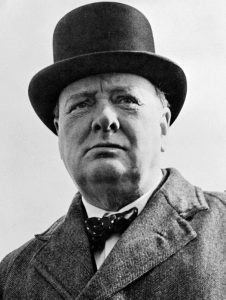 I think we all have one…a second career, or a career that could have been, had we chosen to take a different road in life. Some people actually step back from the career they have, sometimes, to pursue the one that should have been, and others simply know that they could have, if they had chosen to. I was one of those people. I spent much of my working years as an insurance agent, and a good one, I believe, but after spending thirteen years as a caregiver, I also know that I could have been a nurse, had I chosen that road. My daughter, Corrie Petersen chose to make that journey transition, and now she is a nurse, after spending those same thirteen years helping my take care of her grandparents, along with her sister, Amy Royce, children Chris and Josh, niece, Shai Royce, nephew Caalab Royce, and many other family caregivers in our Caregiving Villages, but none of the rest of us made that second career choice.
I think we all have one…a second career, or a career that could have been, had we chosen to take a different road in life. Some people actually step back from the career they have, sometimes, to pursue the one that should have been, and others simply know that they could have, if they had chosen to. I was one of those people. I spent much of my working years as an insurance agent, and a good one, I believe, but after spending thirteen years as a caregiver, I also know that I could have been a nurse, had I chosen that road. My daughter, Corrie Petersen chose to make that journey transition, and now she is a nurse, after spending those same thirteen years helping my take care of her grandparents, along with her sister, Amy Royce, children Chris and Josh, niece, Shai Royce, nephew Caalab Royce, and many other family caregivers in our Caregiving Villages, but none of the rest of us made that second career choice.
Sir Winston Leonard Spencer-Churchill was a British statesman, soldier, and writer who served as Prime Minister of the United Kingdom twice, from 1940 to 1945 during the Second World War, and again from 1951 to 
 1955. Apart from two years between 1922 and 1924, he was a Member of Parliament from 1900 to 1964 and represented a total of five constituencies. He was also a well-known war strategist, and a part of the reason that World War II ended the way that it did. One would think that he knew exactly what his one and only career was, and that he fulfilled his destiny, but he also had another career living inside of him, and some say that he missed his calling. Sir Winston Leonard Spencer-Churchill was a very talented artist. He actually painted 500 paintings, 50 of which were displayed professionally. In fact, it was Picasso, himself, who said that Sir Winston Leonard Spencer-Churchill missed his true calling, and very much could have chosen art as his career. My daughter, Amy Royce could have too, I think, as could my son-in-law, Kevin Petersen, and a number of others in my family. I have almost zero talent when it comes to art, but I am very impressed with those in my family
1955. Apart from two years between 1922 and 1924, he was a Member of Parliament from 1900 to 1964 and represented a total of five constituencies. He was also a well-known war strategist, and a part of the reason that World War II ended the way that it did. One would think that he knew exactly what his one and only career was, and that he fulfilled his destiny, but he also had another career living inside of him, and some say that he missed his calling. Sir Winston Leonard Spencer-Churchill was a very talented artist. He actually painted 500 paintings, 50 of which were displayed professionally. In fact, it was Picasso, himself, who said that Sir Winston Leonard Spencer-Churchill missed his true calling, and very much could have chosen art as his career. My daughter, Amy Royce could have too, I think, as could my son-in-law, Kevin Petersen, and a number of others in my family. I have almost zero talent when it comes to art, but I am very impressed with those in my family 
 who do.
who do.
I suppose that a second career that is never a road taken, would end up being called a “hobby” sometimes, although, I would not consider caregiving a “hobby” in any way, but art could fall into that category…as could writing, which I guess could have been a third career for me. Strangely, I don’t really consider myself to be an author, because I have never published a book. Is internet blogging of stories, publishing? Maybe. And maybe we all have many talents that could easily have turned into careers, had we decided to go down that road, or another road. Maybe, “That Second Career” isn’t really even the right title, nevertheless, it is the title.
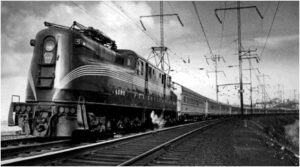 Monday, September 6, 1943, was the Labor Day holiday and the Pennsylvania Railroad company had laid on 16-car trains to accommodate the expected high demand. At 4pm, the passenger count on the premier train, the Congressional Limited was at 541 people on the 16 cars, being hauled by PRR GG1 electric locomotive number 4930, scheduled to travel nonstop from Washington’s Union Station to Pennsylvania Station in New York.
Monday, September 6, 1943, was the Labor Day holiday and the Pennsylvania Railroad company had laid on 16-car trains to accommodate the expected high demand. At 4pm, the passenger count on the premier train, the Congressional Limited was at 541 people on the 16 cars, being hauled by PRR GG1 electric locomotive number 4930, scheduled to travel nonstop from Washington’s Union Station to Pennsylvania Station in New York.
As the train reached Frankford Junction the train derailed in the Kensington neighborhood of Philadelphia, Pennsylvania, killing 79 people and injuring 117 others. As the train passed through the North Philadelphia station, everything seemed to be in order. The train was even coming in a little bit ahead of schedule. It began to slow its speed, but shortly afterward, as it passed a rail yard, workers saw flames coming from a journal box (a hot box) on one of the cars. Jumping into action, they rang the next signal tower at Frankford Junction, but unfortunately, that call came too late. Before the worker who was manning the tower could react, disaster struck as the train passed his signal tower at 6:06 pm traveling at a speed of 56 miles per hour. The journal box on the front of car #7 had seized and an axle snapped, which caught the truck and  catapulted it upwards. The car subsequently struck a signal gantry, which peeled off its roof along the line of windows “like a can of sardines.” From there everything fell apart like a house of cards. Car #8 wrapped itself around the gantry upright in a figure U. The next six cars were scattered at odd angles over the tracks, with only the last two cars remaining undamaged. The scene was one of devastation, with the bodies of the 79 dead lying scattered over the tracks.
catapulted it upwards. The car subsequently struck a signal gantry, which peeled off its roof along the line of windows “like a can of sardines.” From there everything fell apart like a house of cards. Car #8 wrapped itself around the gantry upright in a figure U. The next six cars were scattered at odd angles over the tracks, with only the last two cars remaining undamaged. The scene was one of devastation, with the bodies of the 79 dead lying scattered over the tracks.
Because the derailment happened during wartime, there were a number of servicemen onboard who were on leave. The men immediately jumped into action, helping the injured. Workers from the nearby Cramp’s shipyard arrived with acetylene torches to cut open cars to rescue the injured. That is a long process, that took until the following morning. The rescue work was directed by Mayor Bernard Samuel. The gruesome work of removing the dead was not completed until 24 hours after the accident. The Congressional Limited traveled between Washington DC and New York City, normally making one stop in Newark, New Jersey, covering the 236 miles in 3½ hours at speeds up to 80 miles per hour, which seems fast for the time. All the deaths occurred in cars #7 and #8, and 117 other passengers were injured, some seriously. There were survivors, of course, one of whom was Chinese author Lin Yutang.

The inquiry centered on the journal box on car #7 as the cause of the accident. The railroad mechanics who had inspected and lubricated the box earlier that day swore it had been in good order. Normal practice was for signal towermen to watch passing train wheels for signs of problems and for train crew to look back as trains rounded curves. Somehow, the overheated and eventually burning journal box was missed. How that happened was never explained. Did the towermen and train crew simply become lax in their duties, thinking that nothing ever happened on their train, were they possibly over tired that day, or were the just busy with other tasks. These are questions we will never have answers for, unfortunately.

 When I first met, my husband, Bob Schulenberg’s aunt, Pearl Hein, I liked her immediately. She felt like my own aunt, even before we were married, and she became my aunt too. It was just the natural transition of it. Pearl was so welcoming and easy to get along with. I honestly don’t know anyone who didn’t love her. Bob and I used to go to Forsyth, Montana where his grandparents, aunts, uncles, and cousins lived…most of them anyway. Those who don’t live there, started out in that area. So, we tried to keep our girls, Corrie Petersen and Amy Royce, connected with that part of the family. Pearl and Uncle Eddie were a big part of those visits.
When I first met, my husband, Bob Schulenberg’s aunt, Pearl Hein, I liked her immediately. She felt like my own aunt, even before we were married, and she became my aunt too. It was just the natural transition of it. Pearl was so welcoming and easy to get along with. I honestly don’t know anyone who didn’t love her. Bob and I used to go to Forsyth, Montana where his grandparents, aunts, uncles, and cousins lived…most of them anyway. Those who don’t live there, started out in that area. So, we tried to keep our girls, Corrie Petersen and Amy Royce, connected with that part of the family. Pearl and Uncle Eddie were a big part of those visits.
In those days, Pearl was working at the IGA (a grocery store) and honestly, I think the place would have fallen apart without her. For many years she was a fixture in the place, but now she is retired and gets to spend her 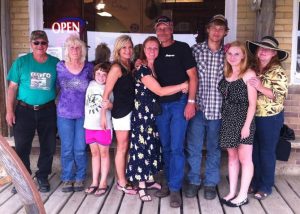
 time doing the things she wants to do. It hasn’t been exactly what she had expected or hoped, because of the loss of her husband, Eddie and then three months later, her son, Larry, but she is slowly coming back to feeling more like herself. These days, she spends some of her time visiting her daughter, Kim Arani and son-in-law, Michael Arani in Texas, and she enjoys that. Sometimes a change of scenery is just what is needed to perk a person up, and mother/daughter time is nice too.
time doing the things she wants to do. It hasn’t been exactly what she had expected or hoped, because of the loss of her husband, Eddie and then three months later, her son, Larry, but she is slowly coming back to feeling more like herself. These days, she spends some of her time visiting her daughter, Kim Arani and son-in-law, Michael Arani in Texas, and she enjoys that. Sometimes a change of scenery is just what is needed to perk a person up, and mother/daughter time is nice too.
Pearl has always had a heart for people. She tries to keep in touch with those closest to her, either by phone or text, and it is always appreciated. We are all busy in life, and so just a periodic text can be an uplifting text can be a bright spot in the day. Pearl still has family in the Forsyth area, and she enjoys getting together with them when she can. She and her sister, Rosalie 
 Steinbach were always close. They helped each other with the care of their parents, and I know their parents were grateful. Caregiving is a tough job, and Pearl knows that better than most people. Pearl is such a loving and caring person, and I’m sure that is why I felt drawn to her so much. She never thinks of herself, always others. She wants to make sure that everyone has what they need to feel comfortable and happy. That is just her nature. Everyone else, above self. That’s Pearl. Today is Pearl’s 74th birthday. Happy birthday Pearl!! Have a great day!! We love you!!
Steinbach were always close. They helped each other with the care of their parents, and I know their parents were grateful. Caregiving is a tough job, and Pearl knows that better than most people. Pearl is such a loving and caring person, and I’m sure that is why I felt drawn to her so much. She never thinks of herself, always others. She wants to make sure that everyone has what they need to feel comfortable and happy. That is just her nature. Everyone else, above self. That’s Pearl. Today is Pearl’s 74th birthday. Happy birthday Pearl!! Have a great day!! We love you!!
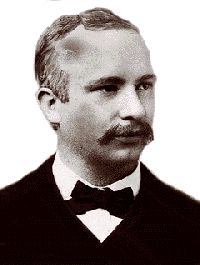 Federal holidays are celebrated for a number of reasons. Labor Day is a federal holiday in the United States celebrated on the first Monday in September. PJ McGuire, Vice President of the American Federation of Labor, is frequently credited as the father of Labor Day in the United States. The day was designed to honor and recognize the American labor movement, as well as the works and contributions of laborers to the development and achievements of the United States. Of course, many people simply look at these “three-day weekend” holidays as a great day to go out of town, sleep in on a normal workday, barbecue, or play golf or some other sport. That wasn’t exactly the plan with these, but many of them do have special events attached to them, such as parades or other celebrations.
Federal holidays are celebrated for a number of reasons. Labor Day is a federal holiday in the United States celebrated on the first Monday in September. PJ McGuire, Vice President of the American Federation of Labor, is frequently credited as the father of Labor Day in the United States. The day was designed to honor and recognize the American labor movement, as well as the works and contributions of laborers to the development and achievements of the United States. Of course, many people simply look at these “three-day weekend” holidays as a great day to go out of town, sleep in on a normal workday, barbecue, or play golf or some other sport. That wasn’t exactly the plan with these, but many of them do have special events attached to them, such as parades or other celebrations.
Labor Day began in the late 19th century, with the first Labor Day being Tuesday, September 5, 1887. As the trade union and labor movements grew, trade unionists proposed that a day be set aside to celebrate labor. “Labor Day” was promoted by the 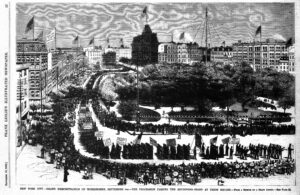 Central Labor Union and the Knights of Labor, which organized the first parade in New York City. Still, it was not celebrated everywhere at that time. In 1887, Oregon was the first state of the United States to make it an official public holiday. Labor Day didn’t become an official federal holiday, until 1894, when thirty states in the US officially celebrated Labor Day. Of course, these holidays didn’t get changed to “Monday Holidays” until the enactment of the Uniform Monday Holiday Act on enacted June 28, 1968. At that time, that made Washington’s Birthday and Memorial Day, as well as Columbus Day permanently on a Monday.
Central Labor Union and the Knights of Labor, which organized the first parade in New York City. Still, it was not celebrated everywhere at that time. In 1887, Oregon was the first state of the United States to make it an official public holiday. Labor Day didn’t become an official federal holiday, until 1894, when thirty states in the US officially celebrated Labor Day. Of course, these holidays didn’t get changed to “Monday Holidays” until the enactment of the Uniform Monday Holiday Act on enacted June 28, 1968. At that time, that made Washington’s Birthday and Memorial Day, as well as Columbus Day permanently on a Monday.
Of all the holidays that are celebrated on Mondays, Labor Day is probably the one that really is somewhat designed for a “three-day weekend” kind of celebration. We were, after all celebrating workers and all they had 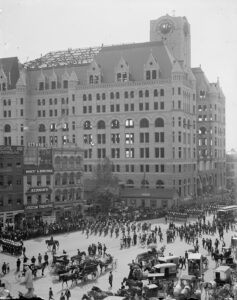 accomplished. When Labor Day was proposed, there was disagreement among labor unions about when a holiday celebrating workers should be. Some people advocated for continued emphasis of the September march-and-picnic date, while others wanted the designation of the more politically charged date of May 1. If you ask me, a May 1st picnic day has a much greater chance of getting rained out, than a September date, but that’s just my opinion. In the end, the September date won out, and now Labor Day is often viewed the “unofficial end of summer” because it marks the end of the cultural summer season. Many take their two-week vacations during the two weeks ending Labor Day weekend. Many fall activities, such as school and sports (particularly football), begin about this time. I’m not sure how many people really think about the labor side of the holiday at all. Nevertheless, they all enjoy the three-day weekend, and all the fun it includes.
accomplished. When Labor Day was proposed, there was disagreement among labor unions about when a holiday celebrating workers should be. Some people advocated for continued emphasis of the September march-and-picnic date, while others wanted the designation of the more politically charged date of May 1. If you ask me, a May 1st picnic day has a much greater chance of getting rained out, than a September date, but that’s just my opinion. In the end, the September date won out, and now Labor Day is often viewed the “unofficial end of summer” because it marks the end of the cultural summer season. Many take their two-week vacations during the two weeks ending Labor Day weekend. Many fall activities, such as school and sports (particularly football), begin about this time. I’m not sure how many people really think about the labor side of the holiday at all. Nevertheless, they all enjoy the three-day weekend, and all the fun it includes.

 For six years now, my son-in-law, Kevin Petersen, who is married to my daughter, Corrie Petersen, has been truly the wind beneath her wings. Corrie has been going to college to get her Batchelor of Science in Nursing degree (BSN), and since the Guiness Book of World Records calls that the hardest degree to get (I fully agree with that assessment, by the way), she has truly needed that wind beneath her wings. In addition to going to school for her degree, Corrie was also working fulltime as a CNA. Kevin was her cheerleader, chef, housekeeper, shoulder to cry on, advisor, and her encouragement when she didn’t think she could go on. While these things are admirable, they often go unnoticed by the rest of the world. While they are all cheering the accomplishments of the student, they tend to forget that support person who is always there in the background to keep that student from stumbling and falling. Nevertheless, Corrie needed Kevin to be there for her, and he was totally dedicated to her and her every need.
For six years now, my son-in-law, Kevin Petersen, who is married to my daughter, Corrie Petersen, has been truly the wind beneath her wings. Corrie has been going to college to get her Batchelor of Science in Nursing degree (BSN), and since the Guiness Book of World Records calls that the hardest degree to get (I fully agree with that assessment, by the way), she has truly needed that wind beneath her wings. In addition to going to school for her degree, Corrie was also working fulltime as a CNA. Kevin was her cheerleader, chef, housekeeper, shoulder to cry on, advisor, and her encouragement when she didn’t think she could go on. While these things are admirable, they often go unnoticed by the rest of the world. While they are all cheering the accomplishments of the student, they tend to forget that support person who is always there in the background to keep that student from stumbling and falling. Nevertheless, Corrie needed Kevin to be there for her, and he was totally dedicated to her and her every need.
Kevin often set aside his own goals and dreams to help Corrie meet her goals, dreams…and deadlines. That meant no vacations for the past six years. Corrie’s school went year-round, so there were no real breaks. Kevin  took care of things on the home front…the pets, cars, house, and meals. He kept things quiet during the days when she had to sleep, because she worked all night. He spent many a night and day alone, because she had to study. Kevin’s support of my daughter was the ultimate show of love, and it makes me very proud of the man she married. Kevin and Corrie love to go camping, but over the last six years, there wasn’t really any time to do that. In addition to everything else going one, Kevin and Corrie had 3 grandchildren (2 more on the way) and their two sons get married, during those six years. Life doesn’t get more hectic than what these two wonderful people were going through, and I know from hectic times in my own life…you can barely think straight when you have everything going on that Corrie had going on. Nevertheless, Kevin was there…holding her hand and more importantly, holding her up.
took care of things on the home front…the pets, cars, house, and meals. He kept things quiet during the days when she had to sleep, because she worked all night. He spent many a night and day alone, because she had to study. Kevin’s support of my daughter was the ultimate show of love, and it makes me very proud of the man she married. Kevin and Corrie love to go camping, but over the last six years, there wasn’t really any time to do that. In addition to everything else going one, Kevin and Corrie had 3 grandchildren (2 more on the way) and their two sons get married, during those six years. Life doesn’t get more hectic than what these two wonderful people were going through, and I know from hectic times in my own life…you can barely think straight when you have everything going on that Corrie had going on. Nevertheless, Kevin was there…holding her hand and more importantly, holding her up.
Now that Corrie’s schooling is finished, and she is working in her dream career…nursing, things have finally settled down. Don’t get me wrong when I say that Kevin is done with the schooling support, because that in no way means that his “support team” duties are over. Those will most likely always be there, because sometimes in nursing, you lose a patient, or one has an outcome that leaves the permanently disabled, or sometimes the fight for the life of a patient is just a difficult one…even when you win. Those are the times when you need your support team a lot. I know that Corrie will always have that great support team, because she has Kevin…the wind beneath her wings, and that will make her road so much easier. Still, the “wind beneath her wings” duties have settled down some, so Kevin and Corrie have been able to go camping twice this summer. They have also had time for a leisurely dinner here and there. They finally have time to be a couple again, and that has been 
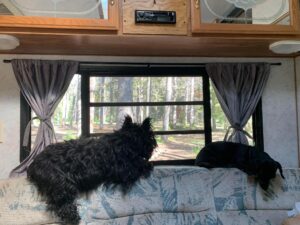 such a blessing for them…and a blessing for this mom and mother-in-law to watch, because I love these “kids” who will always be my “kids” so much, and I want their married life to be filled with every blessing God has to offer them…including a few moonlit nights by the campfire. They deserve so much happiness, and I’m glad they are getting just that. Today is Kevin’s birthday. Happy birthday Kevin, and thanks for taking such good care of my daughter!! Have a great day!! We love you!!
such a blessing for them…and a blessing for this mom and mother-in-law to watch, because I love these “kids” who will always be my “kids” so much, and I want their married life to be filled with every blessing God has to offer them…including a few moonlit nights by the campfire. They deserve so much happiness, and I’m glad they are getting just that. Today is Kevin’s birthday. Happy birthday Kevin, and thanks for taking such good care of my daughter!! Have a great day!! We love you!!
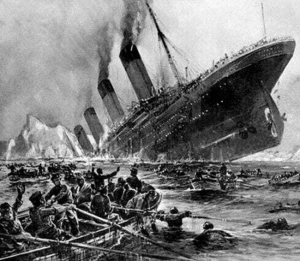
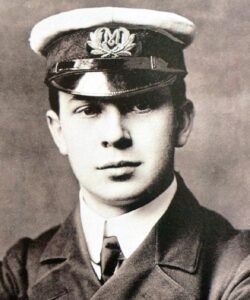 The radioman had done his best. He tried to warn the radioman on RMS Titanic about the dangers lurking in the dark, moonless night…icebergs. Mistakenly believing that Titanic was unsinkable, 25-year-old John George “Jack” Phillips, a British sailor and the senior wireless operator aboard the Titanic during her ill-fated maiden voyage in April 1912, was too busy to listen or heed the warnings. So, the radioman on SS Mesaba turned off his radio and went to bed, making the ship unaware of the disaster the Titanic was experiencing after she hit an iceberg and began to sink. Many rules of the sea changed after that, and from then on, the radio had to be monitored 24/7…in case a disaster happened again. Sadly, safety laws come after disasters.
The radioman had done his best. He tried to warn the radioman on RMS Titanic about the dangers lurking in the dark, moonless night…icebergs. Mistakenly believing that Titanic was unsinkable, 25-year-old John George “Jack” Phillips, a British sailor and the senior wireless operator aboard the Titanic during her ill-fated maiden voyage in April 1912, was too busy to listen or heed the warnings. So, the radioman on SS Mesaba turned off his radio and went to bed, making the ship unaware of the disaster the Titanic was experiencing after she hit an iceberg and began to sink. Many rules of the sea changed after that, and from then on, the radio had to be monitored 24/7…in case a disaster happened again. Sadly, safety laws come after disasters.
So, what happened to the ship that tried to save the Titanic? I had never given that any thought, but now, more than 110 years after the Titanic sank after striking an iceberg, I read that SS Mesaba, the ship that sent warnings to the famous vessel has also been discovered on the ocean floor. Of course, this was not a surprise to those who found the ship, because they knew what had happened to the ship. Those who knew…researchers at Bournemouth University and Bangor University in Wales, sent a team, using multibeam sonar to find the now famed “ship that tried” to save Titanic.
What I didn’t know, until now, was that just six years after the sinking of RMS Titanic, the SS Mesaba was sunk in the Irish Sea during World War I. Mesaba was making a convoy voyage from Liverpool to Philadelphia on September 1, 1918, when a German U-boat’s torpedo took out the merchant ship, killing twenty people. Titanic was finally found in 1985, but the “ship that tried” to save her, took more than 100 years to locate. Possibly it was because of all the new technology we have, including sonar, which “uses sound waves to measure the distance between a sound source and various objects in its surroundings. This kind of method can be used for navigation, communication, and mapping. It is also frequently used by underwater vessels.” The Bangor researchers used active sonar to map the seabed, and also identified the Mesaba wreckage by emitting pulses of sounds and listening for echoes. Innes McCartney, who is a researcher with Bangor, says the multibeam sonar is a “game-changer” for marine technology. Finally, SS Mesaba’s final resting place is known, although 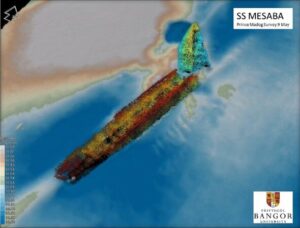
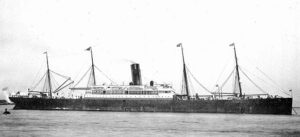 that doesn’t change anything for the ship. After all these years of wondering, the ship will stay right where it is, although it may be explored now and any valuables can be removed by the team, who was the first to locate, and is therefore eligible to salvage if they choose to.
that doesn’t change anything for the ship. After all these years of wondering, the ship will stay right where it is, although it may be explored now and any valuables can be removed by the team, who was the first to locate, and is therefore eligible to salvage if they choose to.
 As we all know, Adolph Hitler was a liar and a murderer. He really never made a move that wasn’t calculated and devious. On September 1, 1939, German forces under the control of Adolf Hitler bombarded Poland on land and from the air. The invasion was more than just a taking of territory. Hitler knew that he might need that area later, and so he did. Hitler had been murdering people that didn’t fit into his mold of “life that had value” and that included Jews, the mentally or physically handicapped, and later gypsies and other ethnicities. Basically, he wanted to eliminate anyone that wasn’t Aryan. Aryan is a word relating to a hypothetical ethnic type illustrated by or descended from early speakers of Indo-European languages. To Hitler it meant white, with blond hair and blue eyes. Oddly, while Hitler had blue eyes, his hair was brown. Somehow that “problem” with his definition of Aryan didn’t concern Hitler. I guess he was happy to be a “special Aryan.” In reality, there are different kinds of Aryans. They can be found with blond, red, brown, white, or black hair, so that wasn’t really an issue either. Hitler considered himself Aryan because he was a native German-speaker, and he knew the definition of “Aryan” as it was used in those days. I don’t think it was ever about Aryan, per se, but rather about getting rid of any group that he decided that he didn’t like.
As we all know, Adolph Hitler was a liar and a murderer. He really never made a move that wasn’t calculated and devious. On September 1, 1939, German forces under the control of Adolf Hitler bombarded Poland on land and from the air. The invasion was more than just a taking of territory. Hitler knew that he might need that area later, and so he did. Hitler had been murdering people that didn’t fit into his mold of “life that had value” and that included Jews, the mentally or physically handicapped, and later gypsies and other ethnicities. Basically, he wanted to eliminate anyone that wasn’t Aryan. Aryan is a word relating to a hypothetical ethnic type illustrated by or descended from early speakers of Indo-European languages. To Hitler it meant white, with blond hair and blue eyes. Oddly, while Hitler had blue eyes, his hair was brown. Somehow that “problem” with his definition of Aryan didn’t concern Hitler. I guess he was happy to be a “special Aryan.” In reality, there are different kinds of Aryans. They can be found with blond, red, brown, white, or black hair, so that wasn’t really an issue either. Hitler considered himself Aryan because he was a native German-speaker, and he knew the definition of “Aryan” as it was used in those days. I don’t think it was ever about Aryan, per se, but rather about getting rid of any group that he decided that he didn’t like.
Hitler’s main purpose for the invasion of Poland was to regain lost territory and ultimately rule their eastern neighbor. Mostly, however, Hitler wanted the world to know exactly how he planned to wage war. This would become the “blitzkrieg” strategy. The Blitzkrieg was a term used to describe “a method of offensive warfare designed to strike a swift, focused blow at an enemy using mobile, maneuverable forces, including armored 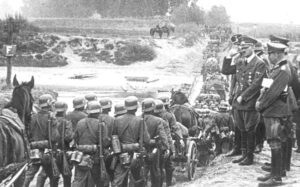 tanks and air support. Such an attack ideally leads to a quick victory, limiting the loss of soldiers and artillery. After the German forces had plowed their way through, devastating a swath of territory, infantry moved in, picking off any remaining resistance.”
tanks and air support. Such an attack ideally leads to a quick victory, limiting the loss of soldiers and artillery. After the German forces had plowed their way through, devastating a swath of territory, infantry moved in, picking off any remaining resistance.”
Hitler was methodical. He established a base of operations within the target country. Then, he immediately began setting up “security” forces to take out anyone who disagreed with his Nazi ideology, whether racial, religious, or political. He set up concentration camps for slave laborers and the extermination of uncooperative civilians. It didn’t take long for the target nation, in this case Poland to become a conquered nation under German rule. Just one day after the German invasion of Poland, Hitler was busy setting up SS “Death’s Head” regiments to terrorize the people. He was preparing for his planned terror.
The Polish army tried to fight back, but they made several severe strategic miscalculations in those early days. Even with an army of 1 million soldiers, the lack of the necessary equipment was a severe detriment to the Polish forces as they attempted to take the Germans head-on, when maybe they should have fallen back to defensive positions. I think the natural way to face an enemy, is head-on. We try to “show no fear” when attacked, but in the end, this thinking, while admirable was probably behind the times, at least in battle, and the brave Polish soldiers were no match for the overwhelming and modern-mechanized German forces. To make matters worse, any hope the Polish soldiers might have had of a Soviet counter-response was lost with 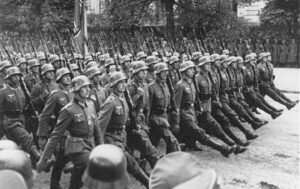 the signing of the Ribbentrop-Molotov Nonaggression Pact…”a non-aggression pact between Nazi Germany and the Soviet Union that partitioned Eastern Europe between them. The pact was signed in Moscow on 23 August 1939 by German Foreign Minister Joachim von Ribbentrop and Soviet Foreign Minister Vyacheslav Molotov and was officially known as the Treaty of Non-Aggression between Germany and the Union of Soviet Socialist Republics. Unofficially, it has also been referred to as the Hitler–Stalin Pact, Nazi–Soviet Pact or Nazi–Soviet Alliance.” Germany invaded Poland on September 1, 1939. Great Britain responded with bombing raids over Germany three days later.
the signing of the Ribbentrop-Molotov Nonaggression Pact…”a non-aggression pact between Nazi Germany and the Soviet Union that partitioned Eastern Europe between them. The pact was signed in Moscow on 23 August 1939 by German Foreign Minister Joachim von Ribbentrop and Soviet Foreign Minister Vyacheslav Molotov and was officially known as the Treaty of Non-Aggression between Germany and the Union of Soviet Socialist Republics. Unofficially, it has also been referred to as the Hitler–Stalin Pact, Nazi–Soviet Pact or Nazi–Soviet Alliance.” Germany invaded Poland on September 1, 1939. Great Britain responded with bombing raids over Germany three days later.
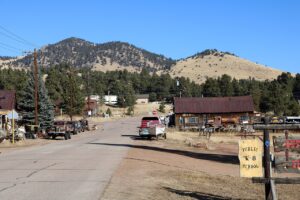
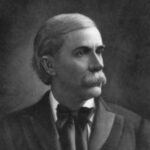 The town of Guffey, Colorado got its start in 1890 with the promise of gold and big money. It quickly attracted prospectors from all over the country. The Cripple Creek mine was just 30 miles away from town, and so the town was the perfect supply hub for mining claims that were expected to spring up between Cripple Creek and Guffey. When Guffey was established, the mining camp was called Idaville, but shortly thereafter its name was changed to Freshwater.
The town of Guffey, Colorado got its start in 1890 with the promise of gold and big money. It quickly attracted prospectors from all over the country. The Cripple Creek mine was just 30 miles away from town, and so the town was the perfect supply hub for mining claims that were expected to spring up between Cripple Creek and Guffey. When Guffey was established, the mining camp was called Idaville, but shortly thereafter its name was changed to Freshwater.
Guffey was actually legally incorporated in 1895, and it was immediately booming as a mining, lumbering, and ranching community. The Freshwater Mining District wasn’t just about gold mines. The area also produced copper, lead, and other minerals. The minerals that could be mined in the area made Guffey a center of activity. For most, gold was the big draw, mostly because they didn’t understand the value of the other minerals, like we do now, with new technologies and new uses for minerals. On August 31, 1896, the Colorado Daily Chieftain reported, “All of the arrangements have been completed, and negotiations closed for the construction of a cyanide mill on Currant Creek, of a capacity of 60-tons per day. The mill is now assured beyond any doubt, and ground will be broken for its construction within a fortnight. The capitalists behind the enterprise are Roadhaven and Vanderpool, of Saint Louis, who have visited the camp several times, investigating our mines and ores, with William Goodman of Cripple Creek, who has been largely instrumental in consummating this enterprise. They claim to be able to treat $7 ore at a profit, which it is claimed will make of Freshwater the biggest camp in the world. The townspeople have guaranteed the company 50 tons of ore per day. This step locates Freshwater beyond the boundary of a prospecting camp and places it in the list of producers.”
The town would receive another name change in the late 1890s, this time due to the fact that there was another town with the same name in California. In honor of James McClurg Guffey, an oilman and capitalist, the town was named Guffey. The town was known throughout the region for its dances, which included lots of fiddlers and other musicians. Guffy reached its peak during this period, with over 500 residents and 40 businesses…most of which were brought in with the promise of gold.
While there were many mines and prospects around Guffey, the total production recorded was disappointingly minor. The cattle ranches and lumber operations located nearby supported Guffey while mining wasn’t profitable. In reality, the town was probably more suited for ranching anyway. Soon many of the businesses began to leave. The Park County Bulletin, dated January 17, 1902, stated, “With this issue, the GUFFEY PROSPECTOR will cease publication. This is due in part to the fact that the camp has another paper and to the additional fact that the Freshwater districts have failed, so far, to develop sufficiently to support a newspaper. The PROSPECTOR has for some time been published from the BULLETIN office, and while working faithfully for the camp, it has never been a paying investment. Those in the Freshwater districts who wish to settle their accounts with the paper can do so with Captain Sylvis at the Guffey post office. To those who wish it, the BULLETIN will be continued to their address, and we will try to make it meet their requirements as always up with the news of Park County. We still have faith in the Freshwater districts and believe that, when sufficient depth has been obtained, there will be pay mines made and profitable mining is done.”
Before long, the people started to move away too. While Guffey still exists today, the community has only around 49 residents and relies heavily on tourism. There are still several of the original structures remaining and are actually occupied. The others have been kept up, though empty, so that the town can keep its historic value and possible income potential for the future. The town currently has a charter school, restaurant, small museum, and more. Guffey continues to be the center of activity for nearby ranches, some of which are Park County Historic Landmarks, including the Aspen Creek/Bener/Moore Ranch, Campbell Ranch, and Thirty-One-Mile Ranch. So, while the town’s size has dwindled, its usefulness has not. Guffey also sits in a very scenic area created by three ancient volcanoes. The Guffey volcanic center is part of the Thirty-nine Mile Volcanic area, the largest remnant of the Central Colorado volcanic field. There are two mineral springs just a mile south of Guffey, that feature spring waters bubbling up from large mounds over 20 feet high and 50 feet across.
Sadly, not all is well in Guffey. As in any town, crime can happen. In January 2001, the bodies of three members of the Dutcher family were found near Guffey. They had been murdered. Later, three teenagers were convicted of the crime. Apparently these three boys had decided to form a paramilitary organization. They were supposedly practicing for future action they planned to take in the country of Guyana. The murders were part of their “practice sessions.” The brutal nature of the crime and its bizarre motive attracted national attention, but really not the kind of attention that the town wanted to be famous for.
The town does have some real oddities that it doesn’t mind being famous for. It would be considered a “somewhat ghost town” and strangely, has a habit of electing animals as Mayor. In fact, while the two main political parties are the Democrats and the Republicans, the current Mayor, Monster the Cat was elected in 
 1998. Lydia Reynolds of Guffey’s 31 Mile Ranch and Bill Sioux of Guffey Garage left us a comment confirming Monster was still alive and well…as of November 2019 anyway. I suppose that in a small town, you could get away with an animal as mayor, but for most of us, that would definitely be odd. Nevertheless, I guess it just adds to the charm of this quaint, old town.
1998. Lydia Reynolds of Guffey’s 31 Mile Ranch and Bill Sioux of Guffey Garage left us a comment confirming Monster was still alive and well…as of November 2019 anyway. I suppose that in a small town, you could get away with an animal as mayor, but for most of us, that would definitely be odd. Nevertheless, I guess it just adds to the charm of this quaint, old town.
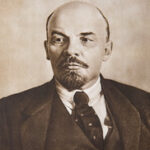
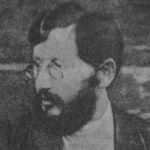 Soviet leader Vladimir Lenin had just finished speaking at a factory in Moscow, when Fanya Kaplan, a member of the Social Revolutionary party shot him twice. Lenin, the leader of the Bolsheviks was seriously wounded, but survived the attack. The attempted assassination basically set off a “gang war” of sorts, although to a much larger degree…a Civil War, really. That war, known as Red Terror, set off a wave of reprisals by the Bolsheviks against the Social Revolutionaries and other political opponents. As Russia fell deeper into civil war, thousands of people were executed. This had been coming since 1887, but would not fully materialize until the assassination of Petrograd Cheka leader Moisei Uritsky and the attempted assassination of Vladimir Lenin.
Soviet leader Vladimir Lenin had just finished speaking at a factory in Moscow, when Fanya Kaplan, a member of the Social Revolutionary party shot him twice. Lenin, the leader of the Bolsheviks was seriously wounded, but survived the attack. The attempted assassination basically set off a “gang war” of sorts, although to a much larger degree…a Civil War, really. That war, known as Red Terror, set off a wave of reprisals by the Bolsheviks against the Social Revolutionaries and other political opponents. As Russia fell deeper into civil war, thousands of people were executed. This had been coming since 1887, but would not fully materialize until the assassination of Petrograd Cheka leader Moisei Uritsky and the attempted assassination of Vladimir Lenin.
Vladimir Ilich Ulyanov was born on April 22, 1870, in Simbirsk, Russian Empire. After his brother was executed in 1887 for plotting to assassinate Czar Alexander III, Ulyanov became interested in the revolutionary cause, also adopting the pseudonym…Lenin. He decided to study law and upon completion, took up practice in Petrograd, which is now Saint Petersburg. In Petrograd, Lenin began to associate with people from the revolutionary Marxist circles. Soon, he was organizing a Marxist group in the capital to enlist workers to the Marxist cause. He called the new group, “Union for the Struggle for the Liberation of the Working Class.” Following the December 1895, arrest of Lenin and the other leaders of the Union, Lenin was jailed for a year. Upon his release, he was exiled to Siberia for a term of three years.
After his term in jail, and the subsequent exile, Lenin went to Western Europe in 1900, where he continued his revolutionary activity. In 1902, while in Western Europe that he published a pamphlet titled “What Is to Be Done?,” which argued that only a disciplined party of professional revolutionaries could bring socialism to Russia. Of course, most of us know that Lenin was working in the shadows to get back into the Russian Marxist system. In 1903, he met with other Russian Marxists in London and established the Russian Social-Democratic Workers’ Party (RSDWP), but while he tried really hard, there was discord from the start. There remained a split between Lenin’s Bolsheviks (Majoritarians), who advocated militarism, and the Mensheviks (Minoritarians), who advocated a democratic movement toward socialism. There is a saying, about a house divided…it just can’t stand. These two groups increasingly opposed each other within the framework of the RSDWP, and Lenin made the split official at a 1912 conference of the Bolshevik Party.
After the outbreak of the Russian Revolution of 1905, Lenin made his move, and returned to Russia. The revolution, which consisted mainly of strikes throughout the Russian empire, came to an end when Nicholas II promised reforms, including the adoption of a Russian constitution and the establishment of an elected legislature. Then, when order had been restored, as often happens in government, the czar nullified most of these reforms. That forced Lenin to go into exile again in 1907.
Lenin was opposed to World War I, which began in 1914, calling it “an imperialistic conflict” and called on “working-class” soldiers to turn their guns on the capitalist leaders who “sent them down into the murderous trenches.” Lenin was pushing for a socialist agenda by appealing to the middle-income people who felt like they should be given a handout by the government to supplement their income. Little did they know that socialism is never the best solution. War is always hard on the countries involved, but World War I was an unprecedented disaster for Russia. The Russian casualties were greater than those sustained by any other nation in any previous war. The war also left the economy hopelessly disrupted by the costly war effort. By March of 1917, things had gotten so bad that riots and strikes broke out in Petrograd over the scarcity of food. To make matters worse, army troops who had lost confidence in the leadership joined the strikers, and on March 15 Nicholas II was forced to abdicate, which brought to an end centuries of czarist rule. Following the February Revolution, so named because of Russia’s use of the Julian calendar, power was shared between the ineffectual Provincial Government and the soviets, or “councils” of soldiers’ and workers’ committees.
German authorities allowed Lenin and his lieutenants to secretly cross Germany en route from Switzerland to Sweden in a sealed railway car, after the outbreak of the February Revolution. The hope was that the return of the anti-war Socialists to Russia would undermine the Russian war effort, which had been continued under the Provincial Government. Lenin began to push for the overthrow of the Provincial Government by the soviets, an act for which he was condemned as a “German agent” by the government’s leaders. Forced to escape to Finland in July, his call for “peace, land, and bread” met with increasing popular support, and the Bolsheviks won a majority in the Petrograd soviet. Then, in October, Lenin secretly returned to Petrograd, and on November 7th the Bolshevik-led Red Guards took down the Provisional Government and proclaimed soviet rule.
Following the coup, Lenin became the virtual dictator of the world’s first Marxist state. His government made peace with Germany, nationalized industry, and distributed land but beginning in 1918, it all began to fall apart. The nation sank into a devastating civil war against czarist forces. In 1920, the czarists were defeated, and in 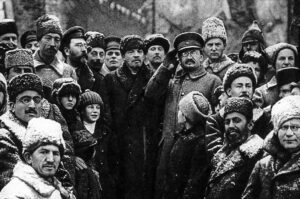
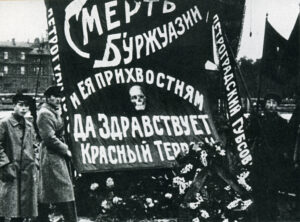 1922 the Union of Soviet Socialist Republics (USSR) was established. Upon Lenin’s death in early 1924, his body was embalmed and placed in a mausoleum near the Moscow Kremlin. Petrograd was renamed Leningrad in his honor. After a struggle of succession, fellow revolutionary Joseph Stalin succeeded Lenin as leader of the Soviet Union. The Lenin years were finally over.
1922 the Union of Soviet Socialist Republics (USSR) was established. Upon Lenin’s death in early 1924, his body was embalmed and placed in a mausoleum near the Moscow Kremlin. Petrograd was renamed Leningrad in his honor. After a struggle of succession, fellow revolutionary Joseph Stalin succeeded Lenin as leader of the Soviet Union. The Lenin years were finally over.
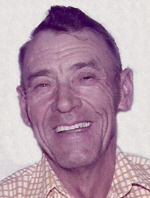
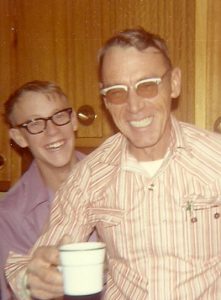 My father-in-law, Walt Schulenberg was such a sweet man, and I miss him very much. He had a gentle yet funny personality, and he was a friend to anyone who knew him. I think that was what made it easy to meet him that first time. When you go to your future in-laws’ home for the first time, you are naturally nervous, but he made me feel at ease, and I have loved him like a second dad ever since. My life was so blessed. I had parents who loved me and who were so good to me, and then I got in-laws that anyone would love to have. How did I get so blessed? I think it was his great personality that made my father-in-law a beloved employee wherever he worked.
My father-in-law, Walt Schulenberg was such a sweet man, and I miss him very much. He had a gentle yet funny personality, and he was a friend to anyone who knew him. I think that was what made it easy to meet him that first time. When you go to your future in-laws’ home for the first time, you are naturally nervous, but he made me feel at ease, and I have loved him like a second dad ever since. My life was so blessed. I had parents who loved me and who were so good to me, and then I got in-laws that anyone would love to have. How did I get so blessed? I think it was his great personality that made my father-in-law a beloved employee wherever he worked.
My father-in-law held a number of jobs over the years, and even the years that I knew him. He worked as a mechanic for Pathfinder Mines (uranium) for a number of years. He quit once an went to work elsewhere, before deciding to go back for a time before switching to maintenance work for Casper College in the mid 80s. While he enjoyed many of his jobs, I think that the years he drove bus for the Casper College T-Birds were some of his favorite years. Not only did he enjoy the students he transported to games, but he got to see some places he might not have been able to see otherwise, and it didn’t cost him anything to go…in fact, he was paid for it. That works.
His working career was long and varied, but I think his retirement years were his real favorites. He had a barn shop in the back yard of his house, and it was there that he got his tinkering fix. He loved to make things and was a skilled carpenter, lawn chair refurbisher, toy maker, rock layer, and a number of other things. He was 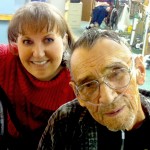
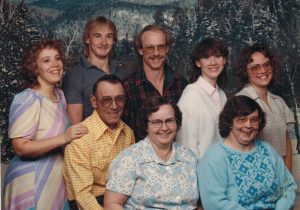 always coming up with new ideas, both for gifts and to sell at the craft fairs his wife Joann Schulenberg and daughter, Brenda Schulenberg loved to do. My father-in-law was a very social person, and really enjoys talking to people. He could often be found standing out in his front yard visiting with people who would stop to look at his wind yard ornaments. It was his recreation, of sorts. He needed that…right up to the end. Today would have been my father-in-law’s 94th birthday. Happy birthday in Heaven, Dad. We love and miss you very much.
always coming up with new ideas, both for gifts and to sell at the craft fairs his wife Joann Schulenberg and daughter, Brenda Schulenberg loved to do. My father-in-law was a very social person, and really enjoys talking to people. He could often be found standing out in his front yard visiting with people who would stop to look at his wind yard ornaments. It was his recreation, of sorts. He needed that…right up to the end. Today would have been my father-in-law’s 94th birthday. Happy birthday in Heaven, Dad. We love and miss you very much.

